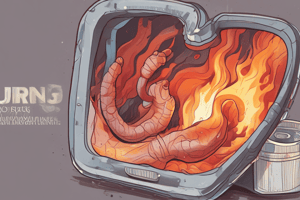Podcast
Questions and Answers
What happens to chemicals when they are in contact with the skin?
What happens to chemicals when they are in contact with the skin?
- They dissolve instantly
- They continue to burn (correct)
- They evaporate quickly
- They stop reacting
Why should chemicals be removed from the skin rapidly?
Why should chemicals be removed from the skin rapidly?
- To prevent infection
- To reduce skin irritation
- To prevent further damage (correct)
- To promote skin healing
What is the consequence of not removing chemicals from the skin quickly?
What is the consequence of not removing chemicals from the skin quickly?
- The skin will be less damaged
- The skin will be unaffected
- The skin will heal faster
- The skin will continue to be damaged (correct)
What is the term for a type of burn caused by radiation?
What is the term for a type of burn caused by radiation?
What is the purpose of removing chemicals from the skin quickly?
What is the purpose of removing chemicals from the skin quickly?
What happens when chemicals are removed from the skin?
What happens when chemicals are removed from the skin?
Why is it important to act quickly when dealing with chemicals on the skin?
Why is it important to act quickly when dealing with chemicals on the skin?
Flashcards are hidden until you start studying
Study Notes
Burns Management
- Minor burns (less than 10%) can be treated on an out-patient basis in a hospital.
- Moderate and severe burns require hospitalization for treatment.
Fluid Requirement for Burn Patients
- Adult patients with burns over 20% of their body require intravenous therapy.
- The Parkland formula calculates the total fluid requirement in 24 hours as: 4ml x TBSA (%) x body weight (kg).
- Fluid administration should be divided into two phases: 50% in the first 8 hours and 50% in the next 16 hours.
Electrical Burns
- When rescuing a person with electrical burns, do not touch the victim with bare hands or iron rods to avoid electrical conduction.
- Use a non-conductive material (e.g., wooden, plastic, cardboard, or rubber) to rescue the person.
- Cover the affected area with a sterile gauze or cloth.
Chemical Burns
- Chemical burns occur when caustic or corrosive substances come into contact with the skin.
- Quickly remove the substance from the victim's skin as it continues to "burn" until removed.
Radiation Burns
- Radiation burns are a type of burn injury. (Note: limited information provided)
Studying That Suits You
Use AI to generate personalized quizzes and flashcards to suit your learning preferences.




